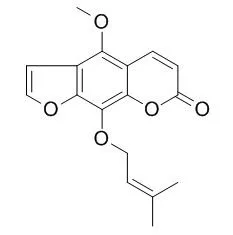| In vitro: |
| Int Immunopharmacol. 2008 May;8(5):670-8. | | Hesperidin, hesperidin methyl chalone and phellopterin from Poncirus trifoliata (Rutaceae) differentially regulate the expression of adhesion molecules in tumor necrosis factor-alpha-stimulated human umbilical vein endothelial cells.[Pubmed: 18387509 ] | The fruits of Poncirus trifoliata (L.) are widely used in Oriental medicine to treat allergic inflammation. Recently, several active compounds including hesperidin, hesperidin methyl chalone and Phellopterin from P. trifoliata (Rutaceae) were isolated and characterized.
METHODS AND RESULTS:
The goal of this study was to investigate the differential effect of hesperidin, hesperidin methyl chalone and Phellopterin derived from P. trifoliata (Rutaceae) on the induction of intercellular adhesion molecule-1 (ICAM-1) and vascular cell adhesion molecule-1 (VCAM-1) by TNF-alpha and the possible molecular mechanisms by which they differentially regulate ICAM-1 and VCAM-1 expressions. Stimulation of human umbilical vein endothelial cells (HUVECs) with TNF-alpha resulted in the increase of ICAM-1 and VCAM-1 expressions, while pretreatment with the three components completely inhibited VCAM-1 expression in a dose-dependent manner but had no effect on ICAM-1 expression. All three compounds failed to block TNF-alpha-induced phosphorylation of ERK1/2, which is involved in regulating ICAM-1 production by TNF-alpha. Furthermore, they efficiently inhibited the phosphorylation of Akt and PKC, suggesting that Akt or PKC pathways are an important target by which these compounds regulate TNF-alpha-induced VCAM-1 but not ICAM-1. Additionally, treatment with these chemicals also inhibited U937 monocyte adhesion to HUVECs stimulated with TNF-alpha. Interestingly, the inhibitory effect of hesperidin, hesperidin methyl chalone and Phellopterin on monocyte adhesion to HUVECs was recapitulated by transfecting cells with VCAM-1 siRNA.
CONCLUSIONS:
Taken together, hesperidin, hesperidin methyl chalone and Phellopterin reduce TNF-alpha-induced VCAM-1 expression through regulation of the Akt and PKC pathway, which contributes to inhibit the adhesion of monocytes to endothelium. | | Neurosci Lett. 1996 Nov 29;219(3):151-4. | | Characterisation of the furanocoumarin phellopterin as a rat brain benzodiazepine receptor partial agonist in vitro.[Pubmed: 8971802] |
METHODS AND RESULTS:
Phellopterin, a naturally occurring furanocoumarin found in the roots of Angelica dahurica, inhibits [3H]diazepam and ethyl 8-fluoro-5,6-dihydro-5-methyl-6-oxo-4H-imidazo[1,5-a][1,4] benzodiazepine-3-carboxylate ([3H]Ro 15-1788) binding to the benzodiazepine site of the rat brain gamma-aminobutyric acidA (GABAA) receptor in vitro with IC50 values of 400 and 680 nM, respectively. Two other naturally occurring furanocoumarins, byakangelicol and imperatorin were significantly less potent, with IC50 values for inhibition of [3H]diazepam binding of 8.0 and 12.3 microM, respectively. Scatchard plot analysis showed that the inhibitory activity of Phellopterin was due to competitive inhibition of the benzodiazepine ligand binding.
CONCLUSIONS:
The results of GABA- and t-butylbicyclophosphorothionate (TBPS)-shift assays suggest that Phellopterin is a partial agonist of the central benzodiazepine receptors in vitro.
|
|






 Cell. 2018 Jan 11;172(1-2):249-261.e12. doi: 10.1016/j.cell.2017.12.019.IF=36.216(2019)
Cell. 2018 Jan 11;172(1-2):249-261.e12. doi: 10.1016/j.cell.2017.12.019.IF=36.216(2019) Cell Metab. 2020 Mar 3;31(3):534-548.e5. doi: 10.1016/j.cmet.2020.01.002.IF=22.415(2019)
Cell Metab. 2020 Mar 3;31(3):534-548.e5. doi: 10.1016/j.cmet.2020.01.002.IF=22.415(2019) Mol Cell. 2017 Nov 16;68(4):673-685.e6. doi: 10.1016/j.molcel.2017.10.022.IF=14.548(2019)
Mol Cell. 2017 Nov 16;68(4):673-685.e6. doi: 10.1016/j.molcel.2017.10.022.IF=14.548(2019)